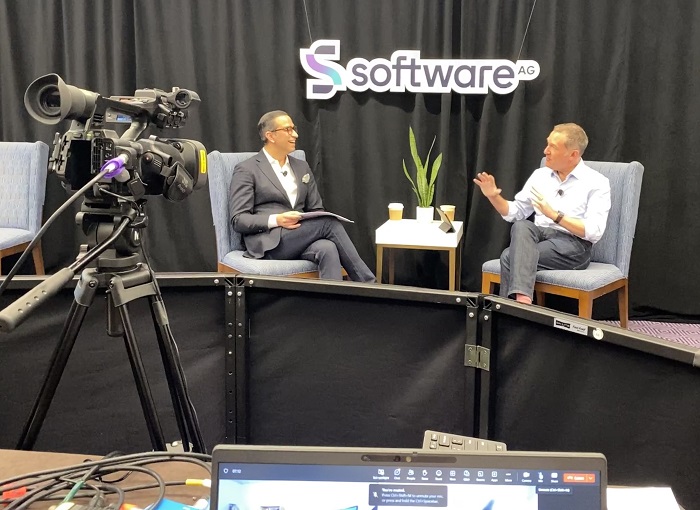
The bigger they come, the harder they fall… unless the Federal Reserve steps in to bail them out. That was the good news for depositors in the now-defunct Silicon Valley Bank, which imploded in a brutal 48-hour run last week. But bond and stockholders lost their hats.
The message to innovators is clear: If you want investment now, you better have your ducks in a row. What does that mean, exactly? Two industry leaders discussed that very topic in a conversation last month that now seems oddly prescient.
At the February sales kickoff for Software AG in Austin, TX, CEO Sanjay Brahmawar sat down with Jim Whitehurst, former President of IBM and CEO of Red Hat, to discuss how to attract investors in challenging times. Little did they know a bank run was imminent.
“A lot’s happening out there in the market,” Brahmawar said, “so it’s quite interesting to hear your perspectives on how investors are looking at opportunities. What is important for them? What should organizations be thinking about as they’re looking to attract investors?”
Whitehurst first noted the elephant in the room — rising interest rates — as a key factor. Cash flow will be king, and that will impact all areas of the business. But that doesn’t mean innovation, or investment, should slow down. If anything, it’s time for entrepreneurs to get smarter.
Other than that obvious market factor, what’s happening now that’s different from patterns of the last 10, 20 or even 40 years? Whitehurst, who served as COO for Delta Airlines before a 12-year stint at Big Blue, offered some compelling perspective:
“For a long time, the core competitive advantage was around driving variants out of processes; standardizing economies of scale. So the tech we used, whether it was ERP systems or analytics, it was all about how to take a known state and make it better and better.”
But that mission can only go so far. Sure, maybe you can make the 110th million car slightly more efficient than the 109th million car, but will that really change the game? At a certain point, you have to take a different approach.
Whitehurst noted that in today’s market, most innovators are no longer focused on trying to make the current state of their business incrementally more efficient. He says the idea now is to figure out which ideas can be fruitful, and then focus on how to scale them quickly.
“How do I put processes in place, technology in place so if I double or triple or quadruple, my costs are only going to go up 20 or 30 or 40 percent?” That’s the mission of today’s innovators: figuring out how to optimize a business architecture that can scale quickly and efficiently.
Forcing Functions
Brahmawar noted that COVID19 served as a forcing function for innovation, though with some side effects: “The pandemic brought a sense of urgency around digital transformation, so a lot of clients really put forward a lot of investment, and in some ways, it moved pretty fast, and that’s what was needed. But they also ended up with a bit of a pileup, a certain amount of technical debt, which needs to be addressed.”
He continued, “The other thing I see is data which is quite fragmented: they’ve got on-prem, they’ve got private cloud, public cloud and edge. This lack of access to data, and being able to bring it together to then apply analytics or turn it into actionable insight, that seems to be quite a challenge… Clients have a lot to do here, but it needs to be prioritized.”
Whitehurst, who has decades of experience working with enterprise data, offered a similar perspective: “How do you get data out of systems that were built to drive efficiency? So you had these standardized systems. Today, you want broader systems that are easier to pull data out of. You want to be able to take meaning out of your processes.”
The ability to “take meaning” out of operational data is crucial for companies today, especially larger organizations that have much more topographically challenging information architectures. Compared to the digital natives, these organizations must find ways to tame the complexity of their environments. This is no small task, especially as competitive and market forces converge.
Last year, Software AG threw down the gauntlet in the data world by acquiring StreamSets for $580 million, signaling a robust appetite for solving the siloed data challenge. In doing so, the company positioned itself for the evolving inflection point in the data industry.
That rubicon can be described with the same magic word that Whitehurst used: scale. The obvious reality to anyone in the data business these days is that the scale of data challenges is off the (old) charts, at least for companies that don’t put in place practical solutions to address it.
Brahmawar touted his company’s strategy for using “thin layers” like StreamSets to provide much-needed data abstraction for organizations. The idea is to create what some consultants call an enterprise backplane, a data layer that enables the movement of key information streams from operational systems into various analytical and AI-fueled environments.
“Providing these thin layers that can help them free up the data, move the data, give more access via API; allow them to create flexibility and agility. That’s exactly the conversation we’re having” with clients, he said.
Whitehurst agreed that getting data out of systems is a must-have in this new era of business. He said there are a couple key ways that companies are innovating these days, and thus opening up new lines of revenue, all driven by access to enterprise data:
“One is intelligence in the thing, so that can be a product,” he said. “Another is understanding how people are using the thing to help them use it in a different way.” A perfect example here would be self-driving cars: Tesla, for example, can now update your software remotely. And location data can be used by retailers and suppliers to optimize supply chains and headcount.
“To do all of that, the capabilities you use to innovate are different than the capabilities you use to make things more efficient,” said Whitehurst. This gets to a larger point around both analytics and AI, which can be used to reinvent or even super-charge business processes.
An Open-Source Future
A key driver for innovation in the data world is the growing community of open-source technologies. IBM and its partner-turned-acquisition, Red Hat, are world-famous for their commitment to open-source technology, and the momentum in that space has fundamentally are perhaps irrevocably transformed the entire industry of enterprise software development.
“You can create value around even around open IP,” Whitehurst explained, “which is what Red Hat has done. But importantly, if you look at where open-source has been really successful, it’s in infrastructure; it’s in databases; it’s in the tools to do devops; it’s in containers; it’s in a lot of the underlying engines. That allows a value migration up higher in the stack.”
And of course those technologies now form the foundation of enterprise architectures. Conferences such as Kubecon are now the epicenter of Fortune 2000 application design and deployment. The entire “observability” space has arguably exploded because of how quickly this new paradigm has taken hold. Containers are the future, and no one doubts that.
In many ways, Kubernetes is now the de facto operating system of the cloud, enabling hyperscalers like Amazon, Microsoft and Google to create massive centers of innovation as they compete for market share.
Brahmawar explained that Software AG’s long-standing position as the Switzerland of enterprise software firms has been, and will continue to be central to the company’s strategy and success.
“I see that as a real unique differentiators for Software AG; being able to have our tech sitting on top of any cloud. The way we’re able to drive innovation with our clients is by working very closely with the hyperscalers, to be able to get returns on these migrations to clouds, accelerate that, and help them consume the capacities that they have committed to.”
So, how can vendors make themselves more attractive to investors, especially in a tightening economy? The short answer is: Prepare to scale! With technologies like ChatGPT4 revolutionizing both creative work and other white-collar functions, the companies that find ways to leverage AI and analytics will rise to the top.
Key to success will be solving for technical debt, ideally via the thin layers that Brahmawar touted. Companies that achieve agility of processes will remain viable. The slow-moving monoliths of yesteryear will likely crash and burn.
About the Author

Eric Kavanagh is CEO of The Bloor Group, a hybrid Media / Analyst firm focused on AI, Analytics, Big Data, Cloud Computing, Digital Transformation, IoT and Government. A serial innovator, he’s the Host of DM Radio, InsideAnalysis and Future Proof; the purveyor of Inside-OpenSource.org; and inventor of MediaLenz. An open-source advocate of 20+ years, he helped evangelize the need for transparency in federal spending, post-Katrina, inspiring the US Federal Funding Accountability and Transparency Act of 2006.
Sign up for the free insideBIGDATA newsletter.
Join us on Twitter: https://twitter.com/InsideBigData1
Join us on LinkedIn: https://www.linkedin.com/company/insidebigdata/
Join us on Facebook: https://www.facebook.com/insideBIGDATANOW





Speak Your Mind